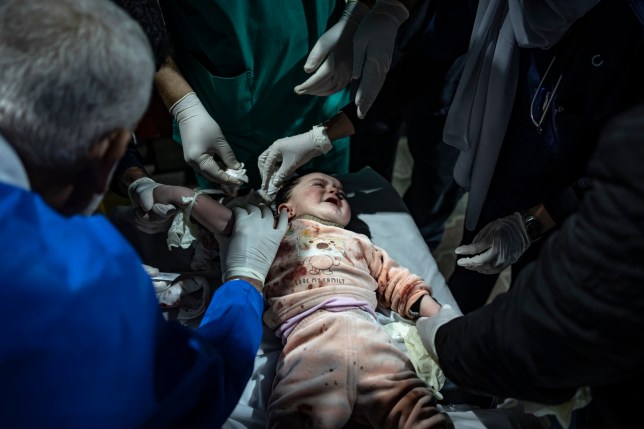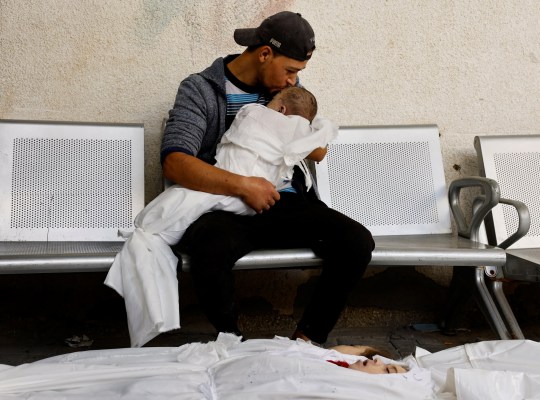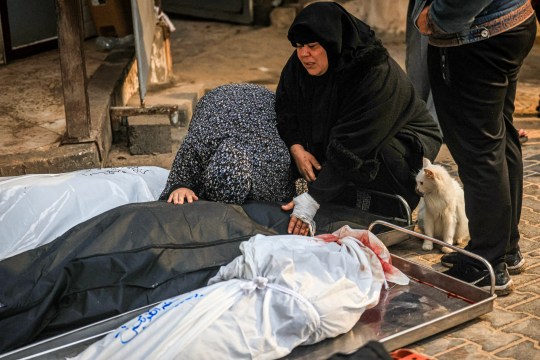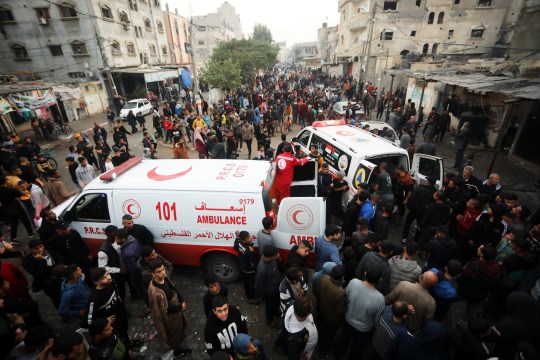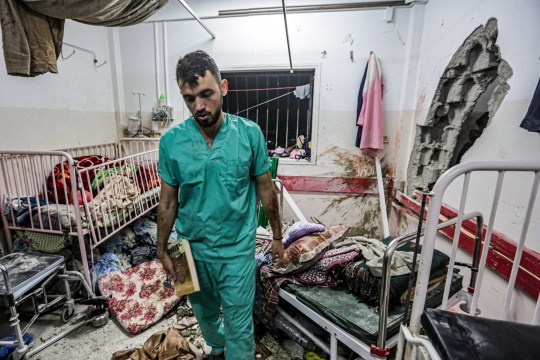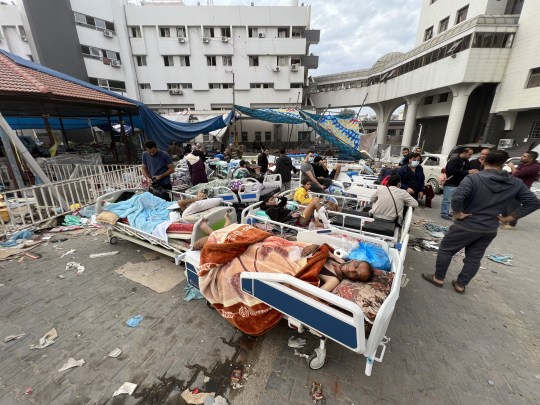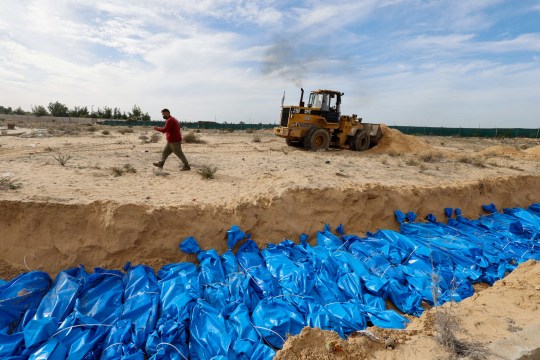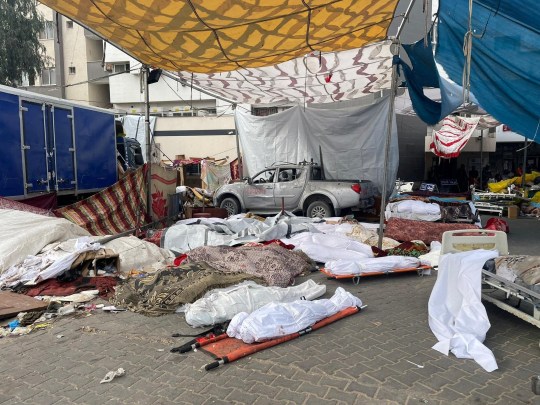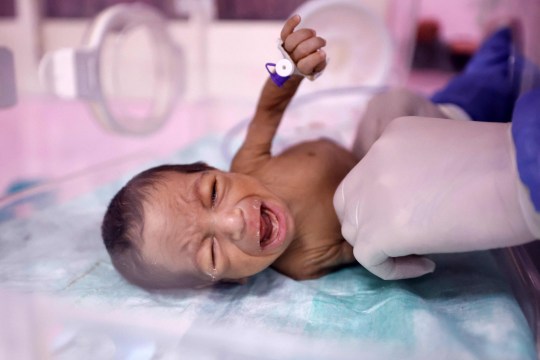In Khan Younis, Gaza, Dr Magdi Jamal’s hospital is at three times its normal capacity after more than 50,000 refugees from the north fled south.
There are no beds in the Nasser Medical Complex. Patients injured in airstrikes are treated on the emergency room floor as they come in. Any ICU surgical cases the hospital had before the war broke out have either died or been evacuated.
And with Israel’s bombardment showing no sign of abating, fears of disease such as diphtheria, mumps and Covid are growing across the besieged enclave.
Dr Magdi tells Metro.co.uk via WhatsApp: ‘The situation is terrible. There are many cases of diseases like acute gastroenteritis, upper respiratory infections, and scabies that come daily – especially kids and older age cases.
‘Most of them that come with severe disease will die due to the lack of medication and delay of medical intervention.’
Patients with normally manageable disease like diabetes, hypertension and scabies who fled from the decimated north are arriving in Khan Younis in terrible condition – there is nowhere left to provide even basic medical care.
Follow Metro on WhatsApp to be the first to get all the latest news
Want to be the first to hear the world’s top stories? Metro.co.uk is now on WhatsApp sending vital updates and top trending stories straight to your phone.
Join the Metro WhatsApp community now for breaking news, juicy showbiz stories and must-watch videos from across our website.
Simply click on this link and select ‘Join Chat’. Don’t forget to turn on notifications so you’ll always be the first to hear the latest!
Dr Magdi adds: ‘Patients that come to us from other hospitals in the north had not enough care – the wounds of some of these people are so contaminated that worms are showing.’
Dr Manal Mohammed, senior lecturer in genomics and infectious diseases at University of Westminster, confirms that cases of contagious diseases are increasing rapidly in Gaza.
It comes weeks after the head of the United Nations Relief and Works Agency in Palestine (UNRWA) issued a similar warning of an ‘imminent’ outbreak.
Dr Mohammed tells Metro.co.uk: ‘Wars are disease amplifiers. They can also cause outbreaks or even pandemics, because a refugee could carry it elsewhere.’
Inside the Strip, the situation is dire. There is already a shortage of oral medications and vaccinations – jabs for children ran out after the war broke out on October 7.
Dr Mohammed adds: ‘We expect to see outbreaks of vaccine-preventable diseases like measles and COVID, mumps, diphtheria, tetanus, pertussis, rubella, and tuberculosis’.
‘And we can’t ignore the antibiotic resistance because of the nature of the wounds in Gaza combined with the tainted environment.’
Wounds of those injured by bombs, debris and shrapnel become easily infected with antibiotic-resistant bacteria in warzones, Dr Mohammed explains.
And even if antibiotics were readily available, they wouldn’t be effective against antibiotic-resistant bacteria.
Dr Mohammed says she has already seen patients with contaminated wounds, and predicts things will only get worse.
Mass graves in Gaza pose further risk of deadly disease, as animal-borne illnesses such as malaria could be spread through mosquitoes, fleas, and rodents near infected bodies.
Dr Mohammed says people are so desperate, they are digging graves without sanitary or hygenic controls.
She says: ‘They are putting hundreds of people in the same place, and you can see loads of discharge coming from these patients.
‘This is a very good environment again for vector-borne diseases which feed on these discharges. This is something that worries me a lot.’
In November alone, more than 30,000 cases of diarrhea were reported in Gaza – predominantly in children below the age of five.
On average before war broke out, just 2,000 cases were reported per month in that age group – an increase which Dr Mohammed says is not coincidental.
Gaza’s death toll – as it stands
More than 18,800 people – an estimated 10,000 infants and children included – have been killed in the Gaza Strip.
More than 55,000 have been wounded in the enclave.
1.9million people in Gaza have been displaced – nearly 85% of the population.
The average number of Internally Displaced People in UNRWA shelters located in the middle and southern areas of Gaza is about 12,400, more than four times their capacity.
She explains: ‘It can be because of bacteria, viruses, parasites, it could be e coli, salmonella, Shigella, viruses like norovirus, rotavirus, parasite, like giardia…’
UNRWA commissioner general Philippe Lazzarini says the situation in Gaza is ‘desperate’ as people are ‘lacking everything’.
In November, the water system shutdown left most of the population drinking contaminated water.
Dehydration and malnutrition are also on the rise, according to the UN’s World Food Programme.
Dr Mohammed says: ‘If people are not killed by rocket attacks, they might die after drinking contaminated water.’
But medics like Dr Magdi continue their work in Khan Younis, even with dwindling supplies of medication and a devastated staff that have been working for two months straight.
Get in touch with our news team by emailing us at webnews@metro.co.uk.
For more stories like this, check our news page.
Get your need-to-know
latest news, feel-good stories, analysis and more
This site is protected by reCAPTCHA and the Google Privacy Policy and Terms of Service apply.

